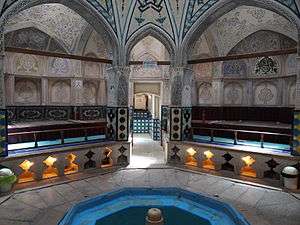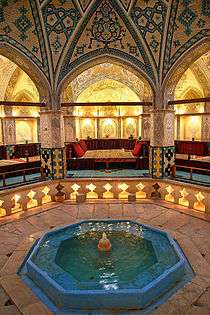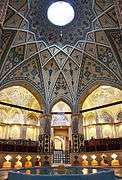Sultan Amir Ahmad Bathhouse

Sultan Amir Ahmad Bathhouse (Persian: حمام سلطان امیر احمد , Hammam-e Sultan Amir Ahmad), also known as the Qasemi Bathhouse, is a traditional Iranian public bathhouse in Kashan, Iran. It was constructed in the 16th century, during the Safavid era; however, the bathhouse was damaged in 1778 as a result of an earthquake and was renovated during the Qajar era. The bathhouse is named after Imamzadeh Sultan Amir Ahmad, whose mausoleum is nearby.
Sultan Amir Ahmad Bathhouse, with an area of around 1000 square meters, consists of two main parts, Sarbineh (the dressing hall) and Garmkhaneh (the hot bathing hall). Sarbineh is a large octagonal hall, which has an octagonal pool in the middle separated by 8 pillars from the outer section. There are four pillars in Garmkhaneh, which make smaller bathing rooms all around as well as the entrance section to Khazineh (final bathing room) in the middle. The interior of the bathhouse is decorated with turquoise and gold tilework, plasterwork, brickwork as well as artistic paintings. The roof of the bathhouse is made of multiple domes that contain convex glasses to provide sufficient lighting to the bathhouse while concealing it from the outside.
Gallery
 Interior decorations, plasterwork
Interior decorations, plasterwork Interior decorations, colorful plasterwork
Interior decorations, colorful plasterwork Interior decorations, plasterwork
Interior decorations, plasterwork Interior decorations, brickwork & tilework
Interior decorations, brickwork & tilework part of the bathhouse is being used as tea house
part of the bathhouse is being used as tea house Interior decorations, brickwork & tilework
Interior decorations, brickwork & tilework The roof domes
The roof domes Entrance to the bathhouse
Entrance to the bathhouse Stone relief above the entrance door
Stone relief above the entrance door
External links
| Wikimedia Commons has media related to Sultan Amir Ahmad Bathhouse. |
Coordinates: 33°58′31″N 51°26′28″E / 33.975203°N 51.441062°E
